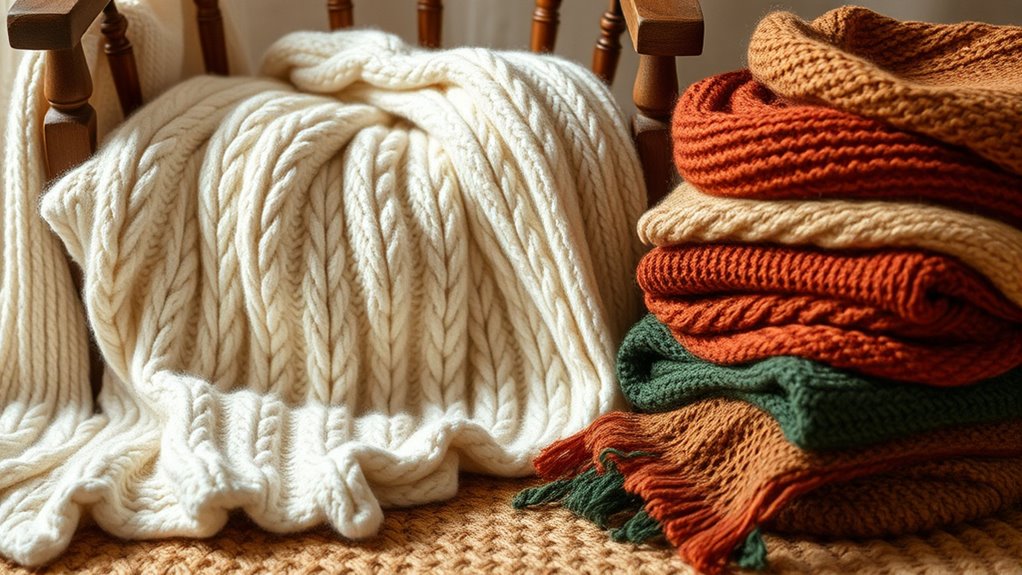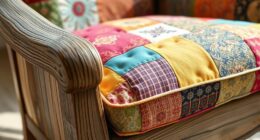To stay warm, choose fabrics with natural insulation like wool, cashmere, or fleece, which trap air and provide excellent heat retention. Synthetic materials such as polyester and nylon wick moisture and trap warm air, especially when blended or layered with natural fibers. Thicker fabrics like velvet and quilted textiles offer more warmth, while lightweight materials like silk or cotton work well when layered. Keep exploring to discover how combining these textiles maximizes comfort in cold conditions.
Key Takeaways
- Natural fibers like wool, cashmere, and merino wool trap air pockets for superior insulation and warmth.
- Synthetic fabrics such as fleece and polyester enhance heat retention by trapping air and wick moisture away from the skin.
- Heavy fabrics like wool, velvet, and quilted materials provide higher thermal resistance and better insulation in cold climates.
- Layering lightweight, moisture-wicking base layers with thicker insulating outer layers improves overall warmth.
- Luxurious textiles like velvet, mashru gaji, and fleece combine style with effective heat trapping for added comfort.
Key Natural Fibers for Insulating Warmth
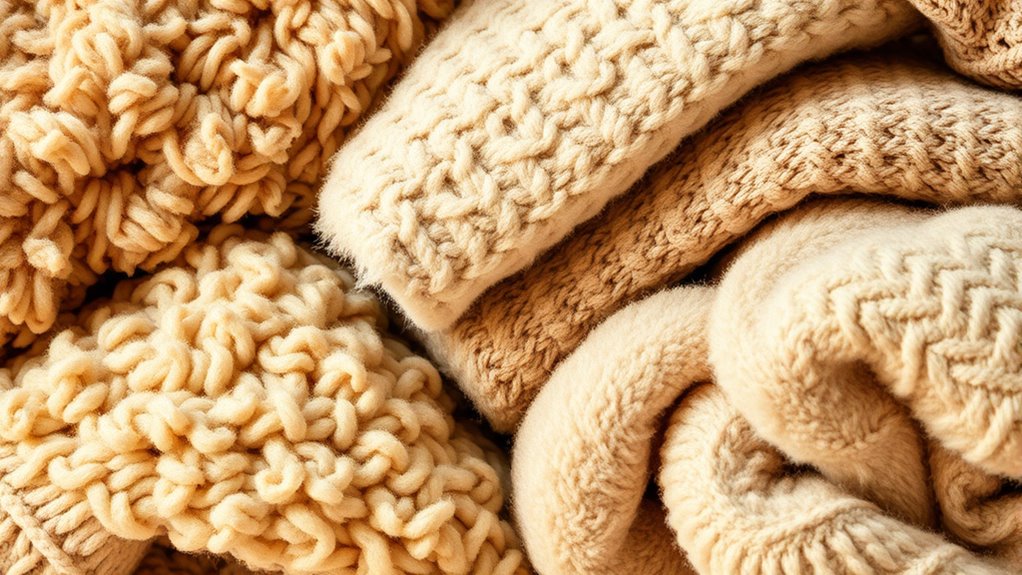
Have you ever wondered why certain natural fibers keep you warmer than synthetic ones? Wool is a top insulator because its fibers naturally form tiny air pockets that trap heat, making it ideal for winter wear. Merino wool takes this a step further with its softness and non-itchy feel, providing warmth without sacrificing comfort.
Icelandic wool, with its dense weave and thick hairs, surpasses cotton and polyester in insulation, keeping you cozy in cold conditions. Cashmere, derived from goats, offers lightweight, ultra-soft warmth, making it a luxurious choice for winter clothing.
These natural fibers not only insulate but also absorb moisture and remain breathable, helping you stay warm and comfortable even in chilly weather. That’s why they’re favorites for cold-weather textiles. Processing techniques in wool manufacturing enhance the fiber’s insulating properties, ensuring optimal warmth retention.
Synthetic Fabrics Enhancing Heat Retention
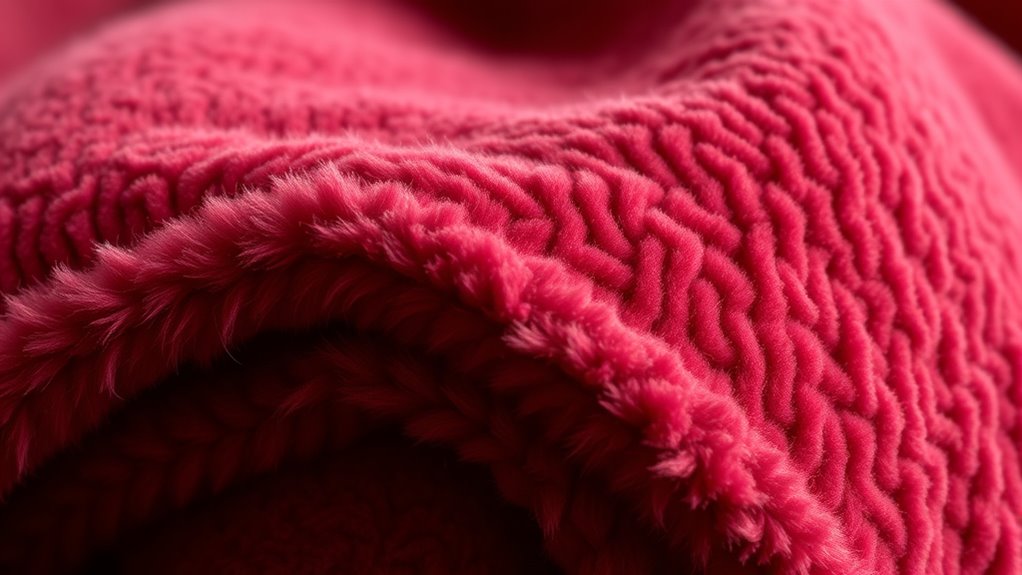
Synthetic fabrics like polyester and fleece are designed to trap air within their fibers, boosting insulation and keeping you warm. They also wick moisture away from your skin, ensuring you stay dry and comfortable in cold conditions. Additionally, blends that combine synthetics with natural fibers enhance durability and water resistance, making them ideal for harsh weather. Advances in AI-powered textile technology are now enabling the development of smarter fabrics that can adapt to changing temperatures and activity levels. Incorporating thermal regulation technologies into fabric design further improves heat retention and comfort in varying environments.
Moisture-Wicking Capabilities
Moisture-wicking fabrics like polyester and nylon are engineered to pull sweat away from your skin, helping you stay dry and comfortable in cold weather. By quickly transporting moisture to the fabric surface, these synthetic fabrics prevent dampness that can reduce insulation. Less water vapor means better heat retention, keeping you warmer longer. Advanced moisture-wicking textiles utilize capillary action to rapidly move sweat outward, where it evaporates efficiently. When blended with natural fibers, synthetic fabrics improve overall heat retention and moisture management. This combination ensures your layers stay dry, maintaining insulation even during intense outdoor activities. Additionally, automation’s role in business intelligence can optimize fabric production processes for better quality control. Understanding the moisture management mechanisms in fabric technology can further enhance the effectiveness of these textiles. Improving fabric breathability is also essential for maintaining warmth without sacrificing comfort. Incorporating innovative synthetic fabric technologies can lead to even more effective moisture-wicking solutions for cold-weather apparel. Moreover, the integration of performance textiles in clothing design continues to evolve, offering enhanced capabilities for cold-weather gear.
Insulation With Synthetic Blends
Ever wonder how fabrics keep you warm even in freezing temperatures? Synthetic blends like polyester and nylon are engineered with tightly woven fibers that trap air, boosting insulation and heat retention. Additionally, some synthetic fabrics incorporate sound wave technology that can enhance thermal properties by influencing heat distribution within the fibers. Fleece, made from polyester, mimics wool’s insulating qualities while remaining lightweight and quick-drying, perfect for winter outdoor gear. These synthetic fabrics also often incorporate moisture-wicking fibers that draw sweat away from your skin, preventing chills and increasing overall comfort. Understanding fiber structure can help you choose fabrics that maximize warmth and comfort in cold environments. Moreover, advancements in fabric technology continue to improve these materials’ ability to retain heat while maintaining breathability.
Durability and Water Resistance
Durability and water resistance are key advantages of synthetic fabrics, making them ideal for harsh winter conditions. These fabrics are designed to withstand wear and tear while keeping moisture out, ensuring lasting performance. Additionally, low light conditions do not significantly impact the effectiveness of synthetic fabrics, maintaining their insulating properties even in less sunny environments. The ability of synthetic fabrics to retain heat under various weather conditions further enhances their functionality for cold climates.
When you wear synthetic fabrics, you benefit from:
- Water-resistant coatings that repel rain and snow
- Tightly woven structures that resist abrasion
- Advanced polymer technologies like Gore-Tex for waterproof and breathable protection
Blended fabrics combine natural fibers with synthetic materials, boosting durability and water resistance without sacrificing warmth.
Synthetic fabrics are engineered to retain heat even when exposed to moisture, helping you stay warm in wet and cold environments. Their resilience makes them a reliable choice for winter outerwear that endures season after season.
Luxurious Materials for Elegant Winter Wear

When choosing luxurious fabrics for winter, cashmere, velvet, and Mashru Gaji stand out as top options that combine elegance with warmth.
Cashmere offers an ultra-soft, plush feel and provides markedly better insulation than fine merino wool, making it perfect for stylish sweaters and scarves.
Velvet adds a rich, tactile texture with its thick, plush surface and a subtle sheen, elevating winter outfits with sophistication.
Mashru Gaji blends silk-like luxury with practicality, featuring tightly woven fibers that trap heat effectively, ensuring you stay warm without sacrificing style.
These fabrics are crafted to deliver both elegance and superior insulation, making them ideal choices for high-end winter wear.
Additionally, the process of selecting the right fabric involves understanding creative practice, which encourages exploring innovative combinations and styles to maximize both comfort and aesthetic appeal.
Incorporating any of these materials ensures you stay cozy and look refined during colder months.
Thermal and Insulating Fabric Options
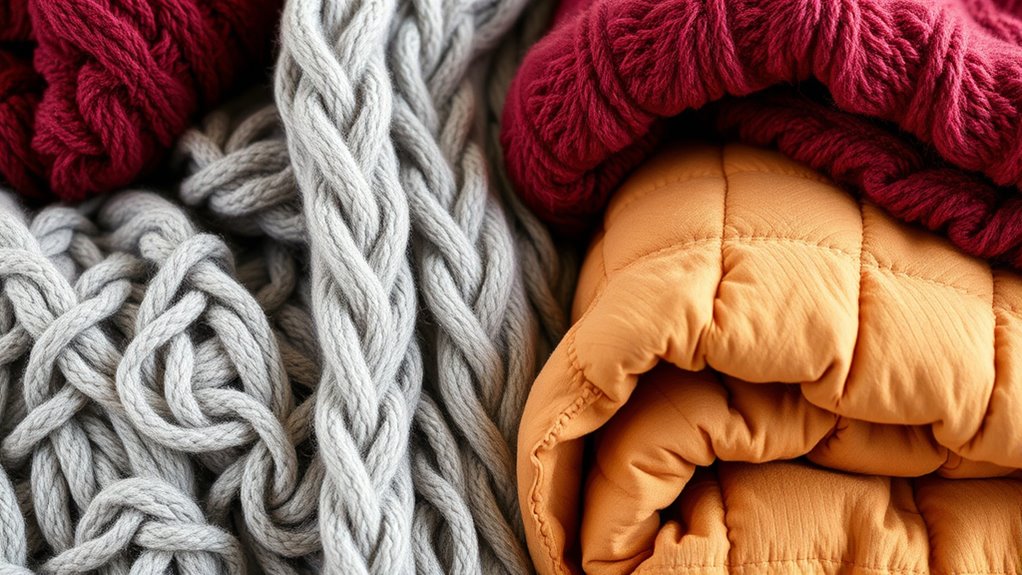
Fabrics like wool, cashmere, and mashru gaji are excellent choices for thermal and insulating wear because their tightly woven fibers trap heat efficiently. Their insulating properties are enhanced by dense structures that create air pockets that trap heat, boosting thermal performance. These air pockets act as tiny barriers, slowing heat transfer and keeping you warmer. Vetted insulation fabrics are also selected for their durability and comfort in cold environments. Velvet and velveteen’s thick, plush textures form a dense barrier that retains body heat, offering superior insulation. Fur, with its natural density and thick hairs, provides unmatched insulation, perfect for extreme cold. High-quality fleece and sherpa polyester mimic natural insulating properties through small air pockets that trap heat while remaining lightweight. Wool, flannel, and polar fleece lock in body heat and repel cold air, making them ideal for chilly conditions, and understanding insulation properties can help you choose the best fabric for your needs. Additionally, the energy efficiency of these fabrics plays a crucial role in their ability to maintain warmth without bulk. Incorporating fabrics with thermal retention capabilities can further enhance their insulating effectiveness, especially in very cold climates.
Ideal Fabrics for Base Layers and Moisture Control

Choosing the right fabrics for base layers and moisture control is key to staying comfortable in cold weather. Silk makes an excellent thermal base layer because it traps air close to your skin while remaining lightweight and breathable. Silk’s natural properties help regulate temperature and prevent moisture buildup, making it a popular choice for layering.
Moisture-wicking fabrics like polyester and blended materials draw sweat away, keeping you dry and preventing chills. Natural fibers such as merino wool also regulate temperature and absorb moisture, maintaining warmth without feeling damp. Many moisture management fabrics are treated with special finishes to resist odors and dry quickly. Layering moisture-wicking base fabrics with insulating outer layers creates an effective system for staying warm and dry during winter activities.
In addition, Kia Tuning options like ECU remapping can optimize vehicle performance, which can be beneficial for winter driving conditions, ensuring your vehicle handles well in cold weather.
Selecting these fabrics assures you stay comfortable and protected from the cold.
Understanding Fabric Weight and Its Impact on Warmth
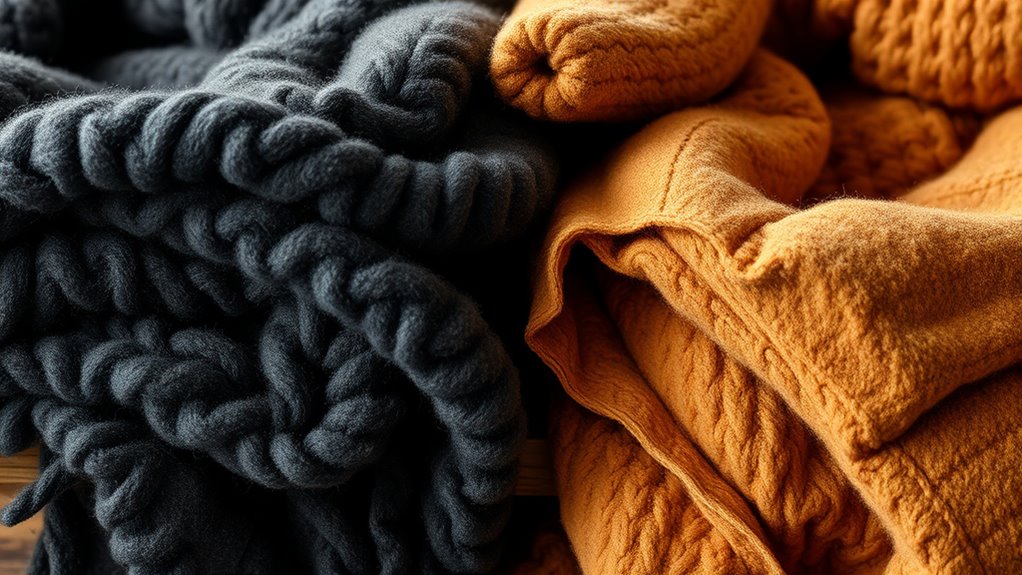
The weight of a fabric directly affects how well it insulates and keeps you warm. Heavier fabrics like wool or velvet trap more heat, making them ideal for cold weather. Trust in the quality of the fabric can also influence its warmth retention capabilities, as well-made materials tend to perform better in insulating heat. Additionally, personal finance management strategies, such as investing in high-quality fabrics, can be considered when planning wardrobe expenses for seasonal needs. Recognizing the difference between Penetration Testing vs Ethical Hacking can help in understanding the importance of selecting the right fabric for different conditions. The fabric’s exfoliating properties can also contribute to skin health, especially when using treatments like glycolic acid to improve skin texture and appearance. This is similar to how fabric weight impacts insulation, as thicker materials provide better protection against cold. Lighter fabrics, such as linen or thin cotton, work well when layered for adaptable warmth.
Heavy Fabrics for Insulation
Heavy fabrics like dense wool and quilted velvet are excellent choices when you need insulation, as they trap more air within their fibers to keep you warm. The increased fabric weight boosts thermal resistance, making them ideal for cold climates. Natural materials like wool also have inherent insulating properties that enhance warmth. Thicker fabrics often have a higher GSM (grams per square meter), which directly enhances their heat-retaining capabilities. When you choose heavy fabrics, you’ll notice:
- Superior insulation through trapped air
- Higher thermal resistance for colder environments
- Better heat retention in outerwear and blankets
While heavy fabrics provide excellent warmth, they can also reduce flexibility and breathability. Balancing weight with comfort is key, and layering multiple heavy fabrics can improve overall insulation without excessive bulk.
Light Fabrics for Layering
When layering for warmth, lightweight fabrics play a crucial role by providing breathable insulation without adding bulk. Fabrics under 4 oz per square yard, like silk, linen, and lightweight cotton, are ideal for creating versatile layers. These fabrics allow your skin to breathe, preventing overheating while still offering extra warmth.
Using lighter textiles in your layering system helps you regulate body temperature, especially in transitional or indoor settings. They work well combined with heavier fabrics like wool or fleece, giving you adjustable insulation for fluctuating temperatures.
Choosing the right light fabrics for layering offers flexibility, enabling you to adapt your warmth level throughout changing winter conditions. This approach keeps you comfortable without sacrificing mobility or comfort.
Outerwear Fabrics Designed for Cold Conditions
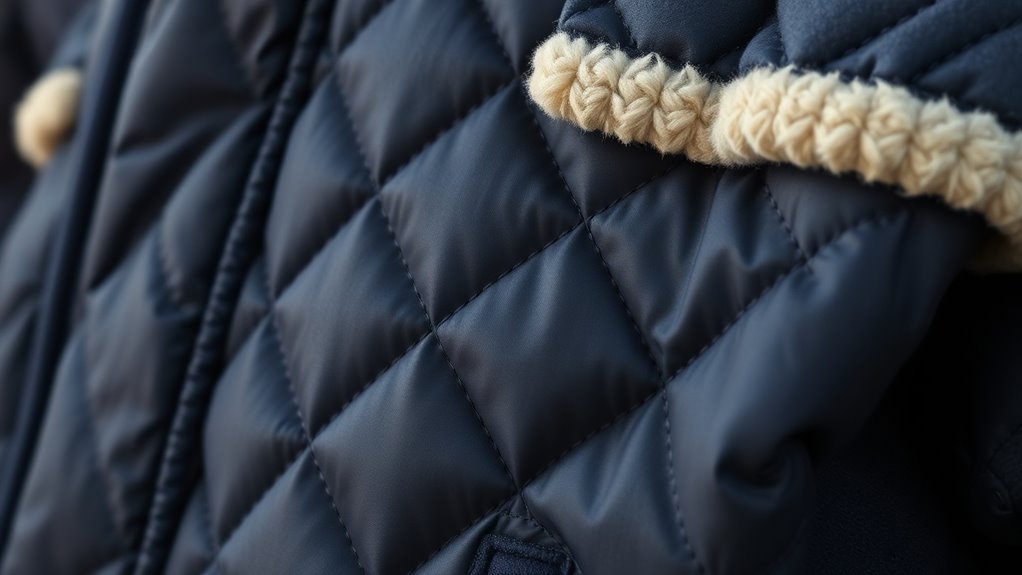
Have you ever wondered how certain fabrics keep you warm in freezing weather? Outerwear fabrics like wool, fleece, and mashru gaji are specially woven or knitted to trap heat and provide insulation.
Wool, especially merino and Icelandic varieties, creates tiny air pockets that effectively retain your body heat. Fleece, made from polyester fibers, mimics wool’s insulating properties with small air pockets that keep warmth close without adding weight.
Mashru gaji’s tightly woven fibers act as a thermal barrier, offering excellent insulation and breathability in extreme cold conditions.
You’ll find these fabrics used in:
- Thick wool coats for maximum warmth
- Lightweight fleece jackets for layering
- Mashru gaji outerwear providing thermal insulation and breathability
Creative Textiles and Layers to Maximize Comfort
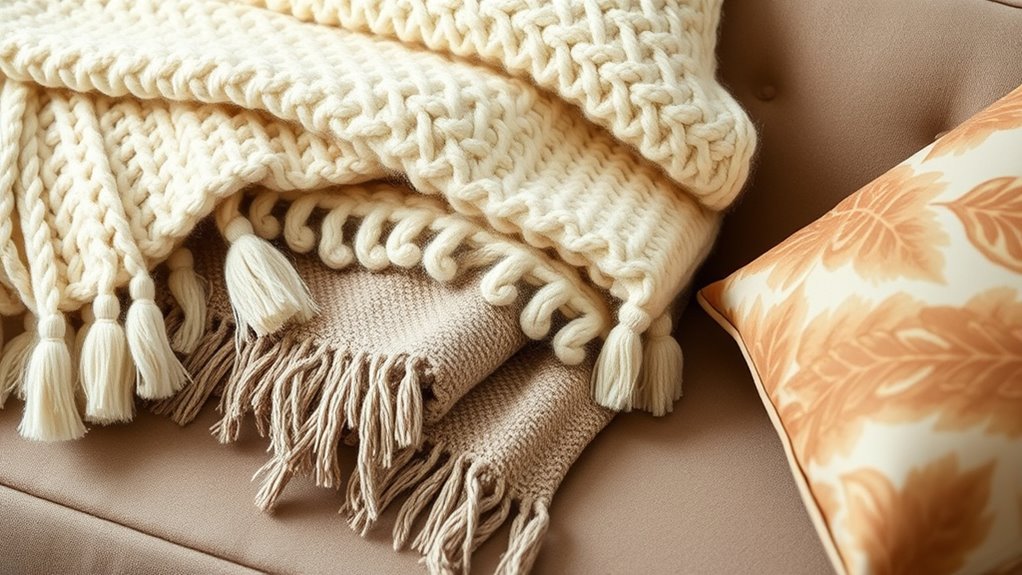
Layering different textiles is an effective way to boost comfort and style while adapting to changing temperatures. By combining fabrics like velvet, flannel, and faux fur, you create visual interest through textural contrast and add tactile comfort.
Mixing materials such as linen or wool with glass, wood, or metals introduces depth and enhances the overall design. Incorporating vintage or globally sourced textiles into furniture and accessories provides unique character and warmth.
Layering textiles with varying weights not only offers flexible insulation but also helps maintain a cozy, inviting atmosphere throughout the seasons. This creative use of textiles elevates your space, making it both functional and visually appealing, all while maximizing comfort by adapting to different conditions with layered textures.
Frequently Asked Questions
Which Fabric Keeps the Most Warmth?
When you ask which fabric keeps the most warmth, you’re looking for the best insulator. Fur, especially thick varieties, traps heat close to your body, making it ideal for extreme cold.
Wool, like cashmere or Icelandic, also offers excellent insulation by trapping air within its fibers.
Synthetic options like polar fleece mimic natural fibers’ warmth.
What Fabric Is Used Mainly for Warmth?
You’re asking which fabric is used mainly for warmth. Wool tops the list because of its natural air pockets that trap heat efficiently.
Fleece, a polyester alternative, also provides great insulation while being lightweight.
Flannel and cashmere are popular too, offering excellent warmth and softness.
For extreme cold, fur offers unmatched insulation by trapping heat close to your body.
Each fabric’s design helps keep you warm in different conditions.
What Fabric Insulates Heat?
Imagine you’re outside in freezing weather, and you notice how your fleece jacket keeps you warm. That’s because fleece insulates heat effectively, thanks to tiny air pockets within its fibers that trap warmth.
When you choose a fabric like fleece, you’re selecting a material designed to prevent cold air from penetrating and to retain your body heat, making it an excellent insulator for cold conditions.
What Fabric Is Best for Extreme Cold?
When facing extreme cold, you need the best insulation to stay warm. Fur is unbeatable because it traps thick hairs close to your body, providing excellent insulation. Wool, especially Icelandic or merino, creates dense air pockets that retain heat.
Velvet and velveteen’s plush pile also offer great warmth. Layering down or quilted fabrics with natural fibers amplifies heat retention, ensuring you stay cozy even in harsh winter conditions.
Conclusion
Think of your winter wardrobe as a fortress, where each fabric acts as a brick guarding you from the cold. By choosing the right natural fibers, synthetic fabrics, and layered textures, you create a warm, cozy haven against winter’s chill. Understanding weight and material helps you build this barrier effectively. With the right combination, you’ll stay comfortable and stylish, turning cold days into a warm embrace rather than an icy challenge.
